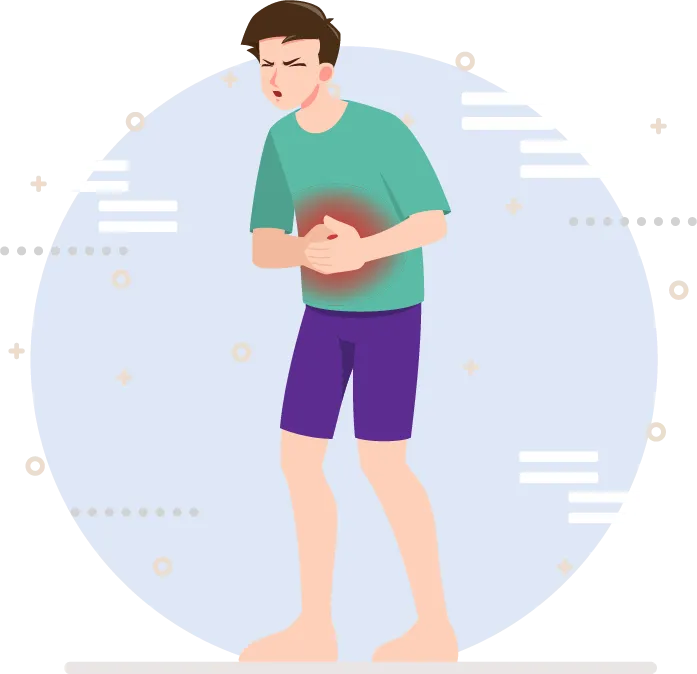Cholesterol | 8 min read
Fatty Liver: Meaning, Stages, Symptoms and Risk Factor
Medically reviewed by
Table of Content
Key Takeaways
- The term non-alcoholic fatty liver disease (NAFLD) is a disorder that can affect people who drink little or no alcohol
- One major aspect of NAFLD is excessive fat storage in liver cells
- Most fatty liver disease stages can frequently be reversed with changes in lifestyle
Your body stores and utilises nutrients as needed, and each type of nutrient has a role to play towards optimal body function. This is true even for fat, which is often demonised in the pursuit of weight loss today. It is important to know that consuming sufficient good fat from your diet helps you stay healthy. However, a problem known as fatty liver disease arises when there is a high level of fatty infiltration of the liver. Alcohol consumption is among the top causes of having a fatty liver and without proper treatment, the consequences can be dire.
Since this disease has very serious health complications, including organ failure, it is well worth it to know all you can about the disease. This way, you can identify the warning signs early on before they turn into symptoms and get a conclusive diagnosis before the condition worsens. Let's know more about it-
What is Fatty Liver?
To understand what it means, it is important to note that having small amounts of fat within the liver is perfectly normal. When the percentage of fat exceeds 5%, it accumulates in the liver that problems start to arise. It is also known as hepatic steatosis and having the disease can cause the liver to scar, which leads to further complications.
Types of Fatty Liver Disease
When it comes to this disease, there are 2 main types: alcoholic fatty liver disease (AFLD) and non-alcoholic fatty liver disease (NAFLD). Within these two types, there are several subtypes and each presents differently. Here is a detailed breakdown to help you understand fatty liver disease better.
Additional Read: Types of Liver ProblemsAlcoholic fatty liver disease (AFLD)
Consuming alcohol excessively damages the liver and this restricts its ability to break down fat. This is the first stage of alcohol-related liver disease and if there’s no inflammation of the liver, it is called simple alcoholic fatty liver.
Alcoholic steatohepatitis (ASH)
Also known as alcohol hepatitis, this occurs when the build-up of fat in the liver is also accompanied by inflammation. If left untreated, ASH can cause cirrhosis, which is liver scarring and can lead to liver failure.
Non-alcoholic fatty liver disease (NAFLD)
This is a reversible stage of liver disease and occurs amongst those who drink little to no alcohol. NAFLD often goes undiagnosed until it worsens and may be called grade 1 fatty liver. In most cases, fat builds up in the liver and can be present without inflammation. If left untreated, it can worsen and lead to other problems like cirrhosis, heart disease, or liver cancer.
Non-alcoholic steatohepatitis (NASH)
NASH is when there is excess fat in the liver and there is inflammation that can damage liver cells. It may be called grade 2 fatty liver. Fibrosis or scar tissue is a common problem due to NASH.
Acute fatty liver of pregnancy (AFLP)
This is quite a rare form of liver disease and occurs during the third trimester of pregnancy. It poses a great risk for the mother and baby, often requiring immediate delivery, as early as possible. The liver disease poses adverse effects felt by both the mother and child, with the mother requiring additional care post-delivery.
Fatty Liver Stages
Simple fatty liver:
There is an accumulation of extra fat in the liver. If it doesn't become worse, simple fatty liver is mostly unharmful.
Steatohepatitis:
In addition to too much fat, the liver is also inflamed.
Fibrosis:
Scarring has now developed in the liver as a result of ongoing inflammation. The liver can still typically perform normally, though.
Cirrhosis:
The liver's capacity to function is hampered by extensive liver scarring. This is the most serious stage, and it cannot be reversed
AFLD and NAFLD both exhibit comparable symptoms. However, fatty liver frequently goes unnoticed without any symptoms. However, you could feel exhausted or have pain or discomfort on the upper right side of your abdomen.
Scarring of the liver is one of the consequences that some persons with fatty liver disease experience. Liver fibrosis is another name for liver scarring. Cirrhosis, a potentially fatal condition that can result in liver failure, is what you get if you have significant liver fibrosis.
The liver damage brought on by cirrhosis is irreversible. It is crucial to stop it from starting in the first place because of this.
Symptoms of cirrhosis include:
- Abdomen ache
- Reduced appetite
- Loss of weight
- Weakness or exhaustion
- Nausea
- Itching skin
- Skin and eyes yellow
- Bruising or bleeding easily
- Urine with a dark colour
- Stools that are pale
- Fluid buildup in the abdomen (ascites)
- Oedema or swelling in your legs
- Web-like blood vessel clusters underneath your skin
- Enlarging breasts in men
- Confusion
It's crucial to adhere to your doctor's prescribed treatment schedule to prevent the fatty liver from worsening and leading to consequences.

Fatty Liver Causes
Simply put, fatty liver is caused when the body doesn’t metabolise fat efficiently, which causes a build-up of fat in the liver as a result. Other causes include:
- Alcohol consumption
- Insulin resistance
- High blood sugar
- Obesity
- Excess belly fat
- Pregnancy
- Exposure to toxins
- Hepatitis C
- Side-effects of medication
- Impaired gut health
Besides these causes, there are also other factors that increase the risk of developing a fatty liver. They are as follows.
- Polycystic ovary syndrome (PCOS)
- Metabolic syndrome
- High cholesterol
Risk Factors of Fatty Liver
Heavy alcohol use is the primary risk factor for AFLD. Heavy drinking, according to the Centers for Disease Control and Prevention (CDC), is defined as:
- 15 or more drinks in a week for males
- Eight8 or more drinks per week for females
According to research, males who drink 40 to 80 grammes of alcohol a day and women who drink 20 to 40 grammes over the course of 10 to 12 years are more likely to develop severe alcohol-related liver damage.
As a point of comparison, a typical drink has roughly 14 grams of alcohol.
Other risk factors for AFLD, besides severe alcohol use, include:
- Older age
- Genetics
- Obesity
- Smoking
- A background in certain illnesses, such as hepatitis C
The following are the main NAFLD risk factors:
- Obesity or excess weight
- Insulin resistance
- Type 2 Diabetes
- Increased cholesterol
- Increased triglycerides
- The metabolic syndrome
Additional NAFLD risk factors include:
- Older age
- Having a family history of liver illness
- Using certain drugs, such as tamoxifen and methotrexate (Trexall),
- (Nolvadex), as well as amiodarone (Pacerone)
- Pregnancy
- A background in certain illnesses, such as hepatitis C
- Polycystic ovary syndrome (PCOS)
- Sleep apnea that is obstructive
- Being exposed to specific toxins
- The quick loss of weight
- Uncommon genetic disorders such as Wilson disease or hypobetalipoproteinemia
Keep in mind that if you have risk factors, your chance of developing fatty liver disease is higher than it is for persons who don't. It does not necessarily follow that you will eventually develop it.
If you have one or more risk factors for fatty liver disease, discuss preventative measures with your doctor.

Fatty Liver Symptoms
In general, a fatty liver doesn’t have any noticeable symptoms at the start. It is only when it worsens and causes inflammation or cirrhosis that the afflicted may experience some discomfort. Here are the symptoms to keep an eye out for.
- Nosebleeds
- Swelling in the legs
- Breast enlargement in men
- Abdominal pain
- Yellow eyes and skin
- Fatigue
- Loss of appetite
- Itchy skin
- Weakness
- Weight loss
- Abdominal swelling
- Confusion
Fatty Liver Treatment
There are no specific medications used to treat this disease but lifestyle changes can help reverse the effects, if in the early stages. These changes include consuming less alcohol, changing your diet, or losing weight. However, if the disease has worsened, you may require surgery or specific medication to counteract the symptoms. In case of liver failure, you may require to undergo an organ transplant. There is also some merit to supplementing vitamin E in your diet, but it is important to consult a specialist about this as there are potential health risks involved with this approach too.
Additional Read: Homeopathic Medicine for Fatty LiverFatty Liver Diet
When learning how to reduce it, the diet has a particularly important role to play. This is because excess carbohydrates are converted into fat and so, watching what you eat can keep you from developing this disease. Here are few diet tips to keep in mind.
Reduce refined carbohydrates
Avoid fructose-rich foods and drinks.
Consume foods that burn liver fat specifically
Whey protein, soluble fiber, monosaturated fats, and green tea can help.
Understanding the disease is important for us, and especially for those who are prone to this condition due to lifestyle choices. Whether you present with signs of fatty liver grade 1 or fatty liver grade 2, the disease should not go unattended. For this reason, knowing how to reduce it properly via home remedies is necessary, even as lifestyle modifications are best complemented with medical advice. Now connecting with the right specialist and availing healthcare is easier than ever thanks to the platform provided by Bajaj Finserv Health.
Additional Read: Foods and Drinks That Are Good for LiverWith it, you don’t have to go through the hassles that come with regular consultations and can enjoy all that telemedicine technology has to offer. This includes online searches for doctors near you, online appointment bookings, and video consultations for remote healthcare services. To add to that, you can also maintain digital patient records and track your health vitals using the health vault feature. This information can then be shared digitally with specialists, thus ensuring optimal fatty liver treatment at all times. Begin your journey towards a healthier lifestyle!
References
- https://www.healthline.com/nutrition/fatty-liver#section1
- https://www.healthline.com/health/fatty-liver#types
- https://www.your.md/condition/fatty-liver-disease
- https://www.healthline.com/nutrition/fatty-liver#section1
- https://www.your.md/condition/fatty-liver-disease
- https://www.healthline.com/nutrition/fatty-liver#section2
- https://www.healthline.com/health/fatty-liver#treatment
- https://www.healthline.com/nutrition/fatty-liver#section4
Disclaimer
Please note that this article is solely meant for informational purposes and Bajaj Finserv Health Limited (“BFHL”) does not shoulder any responsibility of the views/advice/information expressed/given by the writer/reviewer/originator. This article should not be considered as a substitute for any medical advice, diagnosis or treatment. Always consult with your trusted physician/qualified healthcare professional to evaluate your medical condition. The above article has been reviewed by a qualified doctor and BFHL is not responsible for any damages for any information or services provided by any third party.





